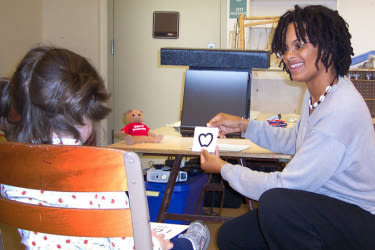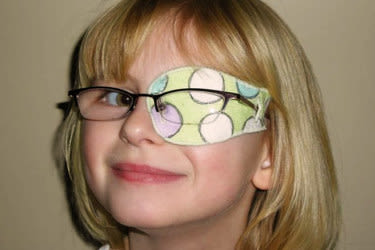The importance of paediatric eye exams

A children's eye exam is an expert assessment of your child's eye health and vision performed by an optometrist or ophthalmologist.
A brief examination of your child’s eyes by a paediatrician or family practice doctor is not a substitute for an eye exam performed by an optometrist or ophthalmologist. Only optometrists and/or ophthalmologists have the advanced training and clinical tools to perform a thorough evaluation of your child's eyes and vision.
Why children's eye exams are important
Eye exams for children are very important to insure your child's eyes are healthy and have no vision problems that could interfere with school performance and potentially affect your child's safety.
Early eye exams also are important because children need the following visual skills that are essential for optimal learning:
Excellent visual acuity at all distances
Accurate and comfortable eye teaming skills
Accurate eye movement skills
Accurate and comfortable focusing skills
When to have your child's eyes examined
Children should have their first comprehensive eye exam at 6 months of age.
They then should have their eyes examined exams at age 3 and just before they start school — at about age 5 or 6.
School-aged children should have an eye exam at least every year, even if no vision correction is required. Children who need spectacles or contact lenses should be examined as recommended by their eye doctor.
Scheduling your child's eye exam
When scheduling an eye exam for your child, choose a time when he or she usually is alert and happy.
Specifics of how eye exams are conducted depend on your child's age, but generally an exam will include a case history, vision testing, determination of whether eyeglasses are needed, testing of eye alignment, an eye health evaluation and, if needed, prescription of eyewear.
After you have made the appointment, you may be sent a case history form by mail. Some eye care practices even have forms on their website that you can download and print at home, before your visit. Or you may not receive a form until you check in at the opticians practice.
The case history form will ask about your child's birth history, including birth weight and whether or not the child was full-term.
Your optician also may ask whether complications occurred during the pregnancy or delivery. Other questions will concern your child's medical history, including current medications and past or present allergies.
Be sure to tell your optician if your child has or displays any of the following:
A history of prematurity
Delayed motor development
Frequent eye rubbing
Excessive blinking
Failure to maintain eye contact
Poor eye tracking skills
Also, be sure to mention if your child has failed a vision screening at school or at a visit to his or her paediatrician.
Your optician also will want to know about previous eye problems and treatments your child has had, such as surgeries and glasses or contact lens wear.
And be sure to inform your optician about any family history of refractive errors, strabismus, amblyopia or eye diseases.
Eye testing for infants
Babies should be able to see as well as adults in terms of focusing ability, colour vision and depth perception by 6 months of age.
To assess whether your baby's eyes are developing normally, the optician typically will use the following tests:
Tests of pupil responses evaluate whether the eye's pupil opens and closes properly in the presence or absence of light.
"Fixate and follow" testing determines whether your baby's eyes are able to fixate on and follow an object such as a light as it moves. (Infants should be able to fixate on an object soon after birth and follow an object by the time they are 3 months old.)
Preferential looking involves using cards that are blank on one side with stripes on the other side to attract the gaze of an infant to the stripes. In this way, vision capabilities can be assessed without the use of a typical eye chart.
Eye testing for preschool children
Some parents are surprised to learn that preschool-age children do not need to know their letters in order to undergo certain eye tests, even when they are too young or too shy to verbalise.

Trained vision screeners may be able to detect certain eye problems in preschoolers. (Image: VIP Study Center, The Ohio State University College of Optometry)
Some common eye tests used specifically for young children include:
LEA symbols for young children are similar to regular eye tests using charts with letters, except that special symbols in these tests include an apple, house, square and circle.
Retinoscopy is a test that involves shining a light into the to observe the reflection from the back of the eye (retina). This test helps determine if your child has any clouding of the lens of the eye (congenital cataract) or significant refractive error.
Random dot stereopsis testing uses special patterns of dots and 3-D glasses to measure how well your child's eyes work together as a team.
In addition to shortsightedness, long sightedness and astigmatism, common vision problems of schoolchildren include:

Your child's eyes should be examined early for vision problems such as "lazy eye" (amblyopia), in which one eye usually is weaker than the other. Eye patching often is used to help strengthen the weaker eye. (Image: Eye-Lids Custom-Made Patches)
Lazy eye (amblyopia). Your optician will want to rule out amblyopia, or "lazy eye," which is decreased vision in one or both eyes without detectable anatomic damage. Unfortunately, amblyopia is not always correctable with spectacles or contact lenses and may require eye patching to strengthen the weaker eye.
Misalignment of eyes (strabismus). Crossed or misaligned eyes (strabismus) can have different causes, such as problems with muscle control in the affected eye or eyes. Strabismus is a common cause of amblyopia and should be treated early in childhood so vision and eye teaming skills can develop normally.
Convergence insufficiency. This is the inability to maintain eye alignment when viewing near objects. Convergence insufficiency can cause eye discomfort and even double vision when reading.
Focusing problems, poor depth perception and colour blindness. Your optician also may test your child's focusing ability (accommodation), depth perception, colour vision and more.
Eye health problems. Your optician will closely examine your child's eyelids to look for abnormal or infected eyelash follicles, bumps, eye discharge and swelling (edema). The optician also will examine the cornea, iris, and lens to look for cloudiness (opacities) or other irregularities.
Vision screening and performance in school
Remember that appropriate vision testing at an early age is vital to insure your child has the visual skills he or she needs to perform well in school.
A child who is unable to see print or view a whiteboard can become easily frustrated, leading to poor academic performance.
Some vision problems, such as lazy eye, are best treated if they are detected and corrected as early as possible while the child's vision system is still developing.
FIND AN OPTICIAN: find appropriate vision testing for your child, visit an optician near you.
Page published on Wednesday, 26 June 2019






